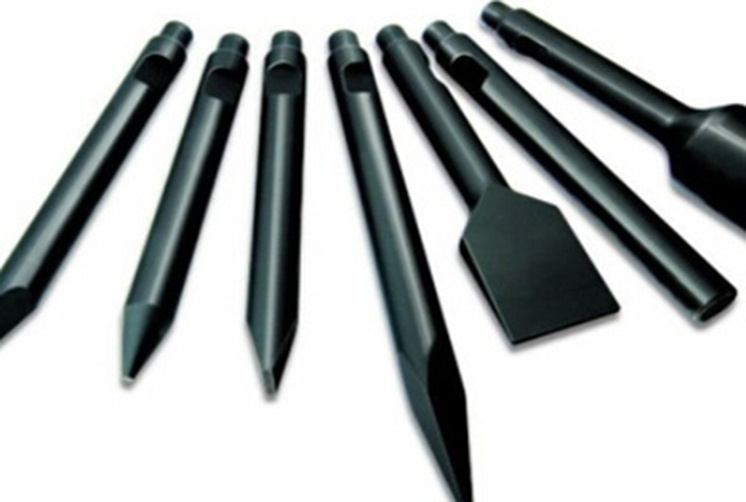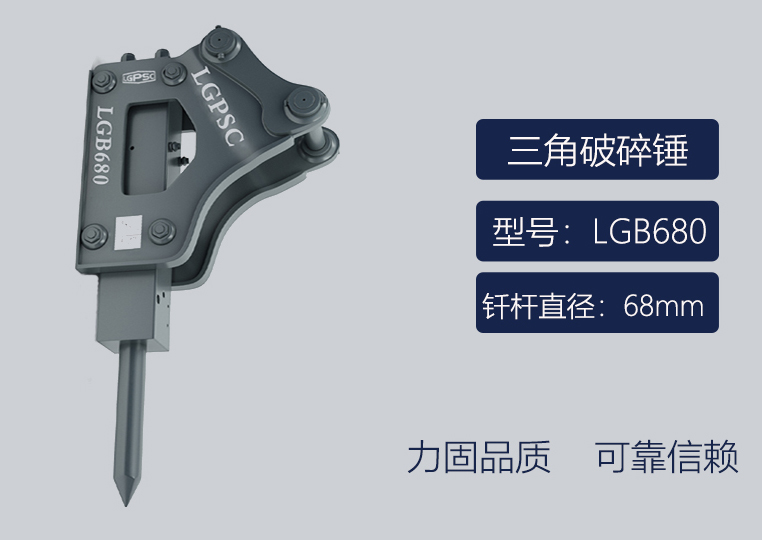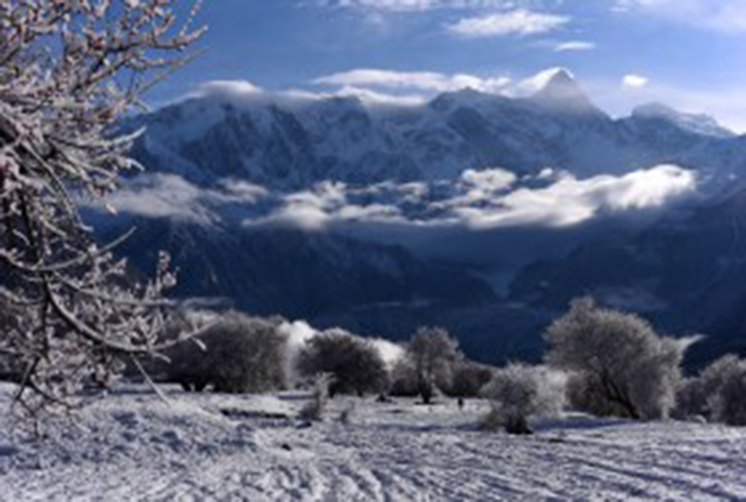
time:2021-09-07 author:admin
Relying on the hydraulic power device, the hydraulic crushing hammer plays the role of impact, hammering and gravel. Due to a series of advantages of wide application range and high work efficiency, the hydraulic crushing hammer is widely used in mining, metallurgy, transportation, railway, tunnel and other industries.
In the use of hydraulic crushing hammer, due to the influence of environment, operation, components and other factors, there will be faults such as poor impact continuity, drop of impact force, insufficient impact frequency, abnormal oil pipe vibration and oil leakage of hydraulic crushing hammer. These faults will affect the performance and efficiency of hydraulic crushing hammer and increase the potential safety hazards of crushing operation. This paper shares several cases of hydraulic breaking hammer failure.
Wechat pictures_ twenty trillion and one hundred and ninety-one billion thirteen million ninety-five thousand seven hundred and fifty-seven jpg
1. The drill rod breaks in a short period of time
Inspection and analysis:
When prying, the drill rod is subjected to the action of F, and a huge moment (M bending) is generated at point a. Point B of the drill rod is under tension and point a is under pressure. Under the action of strong external force F, the drill rod produces some micro crack sources at point B and continues to expand under the action of stress. When the bearing force exceeds the tensile strength limit of the material, the drill rod will be completely broken instantly.
According to the section of the drill rod, it is clearly seen that the starting point of fracture is point B, there are obvious metal tensile cracks around it, the grains at the metal end face are uniform and fine, and there are no small slag inclusion and hidden crack defects. The groove in point a area is a typical reflection of material compression damage.
Conclusion: the broken hammer is used to pry and bend, resulting in the fracture of the drill rod.
2. Abnormal wear of tool rod (and bushing) in a short time
Wechat pictures_ twenty trillion and one hundred and ninety-one billion thirteen million one hundred thousand two hundred and thirty-four jpg
Inspection and analysis: when the hydraulic crushing hammer works, the friction between the drill rod and the bushing will produce a lot of heat. Heat can cause premature wear of drill rods and bushings and damage to components. Therefore, grease shall be added for 2 hours to form an oil film to prevent dry friction and prolong the service life of the drill rod and its bushing.
Conclusion: the wear surface of the drill rod shown in the figure is lack of or no lubricating grease, resulting in serious burns on the contact surface.
3. The stop pin of the drill rod is broken for a short time
Inspection and analysis: according to the drill rod and the broken drill rod stop pin, the upper part of the contact between the drill rod and the stop pin is abnormally worn, but the lower part is almost not worn. The red contact area in the figure is worn far beyond the lower part, and the drill rod is damaged and the retaining pin is broken at the same time, which shows that the last hit object in the crushing work does not stop in time after the fragmentation, and the drill rod strikes the retaining pin of the drill rod many times.
Conclusion: there are more illegal air games.
4. The crushing hammer stops striking
Inspection and analysis: disassemble the hammer body and check the reversing valve. It is found that the sliding valve plug is easy to get stuck. After the valve core of the directional valve was removed, it was found that there were many strain marks on the valve body, resulting in the clamping of the directional valve during operation, the normal direction could not be reversed, and the crushing hammer stopped working.
Main reason: after observing the residual hydraulic oil inside the crushing hammer, it is found that the quality of the hydraulic oil is poor. Check the hydraulic oil flowing out of the excavator pipeline for the same problem. In addition, the inspection found that the oil filter of the crushing hammer pipeline rarely replaced the filter element, and the excavator did not replace the hydraulic oil regularly according to the specified requirements, resulting in the deterioration of the hydraulic oil, which directly affected the directional valve of the crushing hammer.
Conclusion: the directional valve is jammed.
Other reasons why the crushing hammer stops striking:
Improper bushing replacement. After replacing the bushing, the crushing hammer stops working. It does not strike when pressed down, and there is striking action after slightly lifting. After replacing the bushing, the piston position is higher, resulting in that some small directional valve control oil circuits in the cylinder body have been closed at the starting position, the directional valve stops working, and the crushing hammer stops working. (replace the original or regular bushing)
Rear cover oil inlet. (upper cylinder) the crushing hammer gradually becomes weak during the striking process, and finally stops striking. Measure the nitrogen pressure. The pressure is too high. After release, it can strike, and soon stop striking. After measurement, the pressure becomes higher. After disassembly, it was found that the upper cylinder was filled with hydraulic oil, and the piston could not be compressed backward, resulting in the failure of the crushing hammer. (replace seal assembly)
The accumulator components in the line fall into the line. During the inspection, it is found that the deformed parts in the directional valve are stuck in the directional valve.
In addition to the above reasons, the valve plate of the excavator is stuck, or the O-ring on the valve plate comes out of the groove, which also causes the crushing hammer not to strike.
5. Weak impact of crushing hammer
Inspection and analysis: the crushing hammer is weak, and the hose shakes violently on site. The accumulator pressure of the crushing hammer is detected. It is found that the accumulator has no pressure and a little hydraulic oil seeps out. It is judged that the accumulator has been damaged. Remove the accumulator cover, take out the broken leather wrist, clean and dry the accumulator shell and install a new leather wrist.
Conclusion: the skin wrist of the accumulator is broken.
6. Oil leakage at piston
Oil leakage I
Inspection and analysis: during the use of the crushing hammer, a large amount of hydraulic oil leaks from the lower cylinder block and is turbid. It is judged that the sealing component has been damaged. During disassembly inspection, it was found that a large amount of grease and hydraulic oil mixture was mixed between the inner bushing and the piston, and a large amount of dirt was also contaminated on the piston head (see the above figure).
Conclusion: improper grease filling will damage the seal assembly and cause oil leakage at the piston.
Correct filling method: when filling grease, place the crushing hammer vertically and press the drill rod with the crushing hammer, that is, fill when the drill rod is close to the piston and fill it appropriately. There can be wet grease at the drill rod.
Oil leakage phenomenon II
Inspection and analysis: the hydraulic oil leaks from the lower cylinder block when the crushing hammer is stored for a period of time. After inspection, it is found that there is hydraulic oil leakage and the crushing hammer shell is seriously rusted (upper left figure). It may be caused by not doing a good job in moisture protection during storage.
After disassembly and inspection, it was found that there was a section of water rust on the piston head (upper right figure), which directly caused the tensile damage and failure of the piston seal assembly, resulting in the leakage of hydraulic oil.
Conclusion: improper storage will cause piston corrosion, damage sealing components and cause oil leakage.
Correct storage: for long-term storage, the gas in the nitrogen chamber must be discharged to make the piston return to the cylinder body. Refer to the instruction manual.
Oil leakage phenomenon III
Inspection and analysis: a large amount of hydraulic oil leaks from the lower cylinder block of the crushing hammer during use. Through observation, it is found that there is a lot of digging during the use of the crushing hammer. After disassembling the crushing hammer, it is found that there are a large number of small gravel chips inside the shell. After pulling out the piston, it was found that the piston and cylinder block had a large area of tensile damage, resulting in the tensile failure of the sealing assembly and the leakage of hydraulic oil.
Main reason: illegal digging operation brings a large number of small gravel chips into the hammer body. Part of the gravel is attached to the front end of the piston and brought into the cylinder block with the reciprocating movement of the piston. On the one hand, it rubs between the piston and the cylinder block, pulling the piston and the cylinder block, on the other hand, it directly damages the sealing components, resulting in hydraulic oil leakage.
Conclusion: improper operation and use will cause piston strain, damage sealing components and cause oil leakage.
7. The front end of the piston is damaged
Inspection and analysis: metal fragments fall from the lower cylinder during the use of the crushing hammer. After disassembly and inspection of the crushing hammer, it was found that the striking surface at the front end of the piston was damaged (see the figure above), and the drill rod used was not damaged.
Main reason: the hardness of the drill rod is higher than that of the piston rod, which directly damages the piston. The drill rod itself is a lossy part, and its service life is lower than that of the piston, so the hardness is strictly controlled and mastered.
Too soft, too short service life and too hard damage to the piston, so it is strictly prohibited to use non pure drill rods for the crushing hammer. The piston head is corrected and leveled by a grinder and can be used at a certain limit size. If it stops working after repair, please replace the piston.
Conclusion: the hardness of the drill rod does not match that of the piston.
Correct operation is conducive to efficient crushing. In case of improper operation, the striking force cannot be brought into full play, but will reverberate to the crusher body, guard plate and the operating arm of the excavator body, resulting in damage to the parts of the crushing hammer. Correctly operate and maintain the hydraulic breaking hammer to avoid some faults and get twice the result with half the effort!
2021
Good operation and maintenance habits can avoid excessive consumption of drill rods. Here are some examples in this regard.

2021
Relying on the hydraulic power device, the hydraulic crushing hammer plays the role of impact, hammering and gravel. Due to a series of advantages of wide application range and high work efficiency, the hydraulic crushing hammer is widely used in mining, metallurgy, transportation, railway, tunnel and other industries.

2021
As the saying goes, if you don't do it in 1929, walk on the ice in 3949 and look at the willows along the river in 5969. Now is the coldest time of the year. For friends who use the broken hammer, maybe some have left the love hammer idle, or some are still struggling in the cold days. Now let's share how to make the crushing hammer survive the winter safely:


Good operation and maintenance habits can avoid excessive consumption of drill rods. Here are some examples in this regard.

Relying on the hydraulic power device, the hydraulic crushing hammer plays the role of impact, hammering and gravel. Due to a series of advantages of wide application range and high work efficiency, the hydraulic crushing hammer is widely used in mining, metallurgy, transportation, railway, tunnel and other industries.

As the saying goes, if you don't do it in 1929, walk on the ice in 3949 and look at the willows along the river in 5969. Now is the coldest time of the year. For friends who use the broken hammer, maybe some have left the love hammer idle, or some are still struggling in the cold days. Now let's share how to make the crushing hammer survive the winter safely:




Telephone consultation
15165525067

Back to top